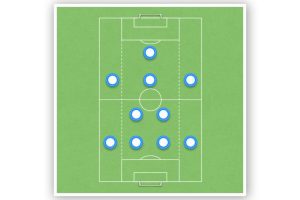The Pros and Cons of Playing a Counter-Attacking Style in Soccer: A Comprehensive Analysis
Counter-attacking is a popular soccer play style that many teams have used to great effect. It involves quickly transitioning from defense to attack when the opponent loses possession of the ball. This style of play can be very effective against teams that like to dominate possession, as it allows the counter-attacking team to exploit the spaces left behind by the opposition.
There are several pros and cons to playing a counter-attacking style in soccer. On the one hand, counter-attacking can be a very effective way to score goals and win games. It requires a well-organized defense that is able to quickly transition into attack, and a group of attackers who are fast and clinical in front of goal. Counter-attacking can also be a good way to frustrate opponents who like to dominate possession, as it forces them to take risks and leaves them vulnerable to counter-attacks.
On the other hand, there are also some potential drawbacks to playing a counter-attacking style. One of the main issues is that it can be difficult to maintain possession of the ball, as the emphasis is on quick transitions rather than building up play slowly. This can put a lot of pressure on the defense, as they may be required to defend for long periods of time without the ball. Additionally, counter-attacking can be less effective against teams that are well-organized defensively, as they may be able to nullify the counter-attacking threat by sitting deep and denying space in behind.
Pros of a Counter-Attacking Style
A counter-attacking style of play is a popular strategy in soccer that involves absorbing pressure from the opposition and quickly transitioning into attack when the opportunity arises. This style of play has its advantages and disadvantages. This section will focus on the pros of a counter-attacking style of play.
Quick Transition
One of the biggest advantages of a counter-attacking style of play is the ability to transition quickly from defense to offense. When the opposition loses possession of the ball, the team can quickly release the ball to a fast player who can exploit the space left by the opposition. This can lead to a quick and unexpected attack that catches the opposition off guard.
Counter-attacking teams often have a few fast players who can run with the ball at high speed and can make quick decisions. These players can be a nightmare for the opposition as they can create chances out of nothing. This style of play is particularly effective against teams that like to press high up the pitch as it leaves space behind for the counter-attacking team to exploit.
Exploiting Opposition Weaknesses
A counter-attacking style of play can also effectively exploit the weaknesses of the opposition. When the opposition is attacking, they often leave gaps in their defense that can be influenced by a counter-attacking team. If the opponent is slow to recover or has poor defensive organization, a counter-attacking team can quickly take advantage of these weaknesses and score a goal.
Counter-attacking teams often have a solid defensive structure that can absorb pressure from the opposition. This means that they can defend deep and wait for the opposition to make a mistake before launching a counter-attack. This style of play is particularly effective against possession-based teams that like to dominate the ball as it frustrates them and can force them into making mistakes.
| Advantages of a Counter-Attacking Style |
|---|
| Quick transition from defense to offense |
| Exploits weaknesses in opposition defense |
| Can frustrate possession-based teams |
Overall, a counter-attacking style of play can be a useful weapon in a team’s arsenal. It can be particularly effective against possession-based teams and can exploit weaknesses in the opposition defense. However, it is not without its drawbacks, which will be discussed in the next section.
Cons of a Counter-Attacking Style
Lack of Possession
One of the main drawbacks of playing a counter-attacking style in soccer is that it often results in a lack of possession. When a team sits back and waits for the opposition to make a mistake, they are not actively trying to control the ball and create scoring opportunities. This can lead to long periods of time where the team is defending and not able to create any chances to score.
Furthermore, if the team is not able to win the ball back quickly, they may find themselves under constant pressure and unable to get out of their own half. This can lead to fatigue and mistakes, making it even more difficult to launch effective counter-attacks.
Risk of Defensive Errors
Another potential downside of playing a counter-attacking style is the risk of defensive errors. When a team is focused on defending and waiting for the opposition to make a mistake, they may not be as organized or focused on their defensive duties as they should be. This can lead to mistakes such as missed tackles, poor marking, and miscommunications, which can result in goals for the opposition.
Additionally, playing a counter-attacking style often requires a high level of athleticism and speed from the defenders. If the defenders are not able to keep up with the opposition’s attackers, they may be caught out of position and unable to recover in time to prevent a goal.
| Cons of Counter-Attacking Style | |
|---|---|
| Lack of Possession | Can lead to long periods of time without creating chances to score |
| May result in constant pressure and difficulty getting out of own half | |
| Risk of Defensive Errors | Team may not be as organized or focused on defensive duties |
| Requires high level of athleticism and speed from defenders |
When to Use a Counter-Attacking Style
Counter-attacking is a style of play that can be effective against certain opponents and in certain situations. Here are a few scenarios where a team might want to consider using a counter-attacking style:
Against Stronger Opponents
When facing a stronger opponent, a team may choose to sit back and defend in numbers, looking to hit their opponents on the break with quick counter-attacks. This can be an effective way to catch the opposition off guard and create scoring opportunities. By staying compact and organized defensively, the team can frustrate their opponents and limit their chances, while also looking to exploit any gaps that open up in the opposition’s defense.
However, it’s important to note that this style of play requires a lot of discipline and concentration from the entire team. Players need to be aware of their defensive responsibilities and be ready to spring into action when the opportunity arises.
When Defending a Lead
Another situation where a team might consider using a counter-attacking style is when defending a lead. By sitting back and inviting pressure from the opposition, the team can look to hit their opponents on the break and extend their lead. This can be particularly effective if the opposition is committing a lot of players forward in search of a goal.
However, as with any defensive strategy, there is always a risk that the opposition will break through and score. It’s important for the team to remain focused and organized defensively, while also looking to take advantage of any opportunities that arise on the counter-attack.
| Pros | Cons |
|---|---|
| Can be effective against stronger opponents | Requires a lot of discipline and concentration from the entire team |
| Can create scoring opportunities on the break | Can be risky if the opposition breaks through and scores |
| Can be effective when defending a lead | May not be suitable against weaker opponents who sit back and defend |
Conclusion
Playing a counter-attacking style in soccer can be an effective strategy for teams looking to take advantage of quick transitions and exploit the opposition’s defensive weaknesses. However, it also comes with its own set of challenges and risks.
On the positive side, counter-attacking can be a great option for teams with fast and agile players who are comfortable playing out of possession. It can also be a useful tool against teams that like to dominate possession and leave gaps in their defense when they push forward.
However, playing a counter-attacking style can also be risky. Teams that rely too heavily on counter-attacks can become predictable and easier to defend against. They may also struggle against teams that sit back and defend deep, as they may not have the necessary creativity and patience to break down a compact defense.
Ultimately, the decision to play a counter-attacking style should be based on a team’s strengths and weaknesses, as well as the opposition they are facing. It can be a valuable addition to a team’s tactical arsenal, but it should not be relied upon as the sole strategy for success.








